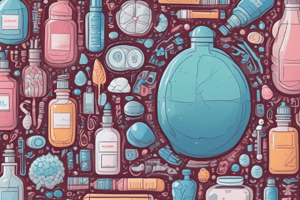Podcast
Questions and Answers
Which type of drugs target hormone receptors on cancer cells or interfere with hormone production?
Which type of drugs target hormone receptors on cancer cells or interfere with hormone production?
- Hormonal therapy agents (correct)
- Antibiotic agents
- Immunotherapy agents
- Chemotherapy agents
Which condition can develop due to impairment of bone marrow function by chemotherapy drugs?
Which condition can develop due to impairment of bone marrow function by chemotherapy drugs?
- Arthritis
- Osteoporosis
- Asthma
- Neutropenia (correct)
What is a common gastrointestinal side effect of chemotherapy?
What is a common gastrointestinal side effect of chemotherapy?
- Heartburn
- Dizziness
- Constipation (correct)
- Hiccups
What is a common side effect of chemotherapy due to damage to rapidly dividing cells like those in hair follicles?
What is a common side effect of chemotherapy due to damage to rapidly dividing cells like those in hair follicles?
How do treatment teams help manage chemotherapy side effects?
How do treatment teams help manage chemotherapy side effects?
Which organ can be damaged by some chemotherapy drugs?
Which organ can be damaged by some chemotherapy drugs?
Which category of chemotherapy drugs mimic natural cellular components, disrupting DNA synthesis and cell division?
Which category of chemotherapy drugs mimic natural cellular components, disrupting DNA synthesis and cell division?
Which type of chemotherapy drugs form covalent bonds with DNA, leading to double-strand breaks and cell death?
Which type of chemotherapy drugs form covalent bonds with DNA, leading to double-strand breaks and cell death?
What is the mechanism of action of antitumor antibiotics in chemotherapy?
What is the mechanism of action of antitumor antibiotics in chemotherapy?
Which group of chemotherapy drugs target enzymes essential for DNA unwinding during cell division?
Which group of chemotherapy drugs target enzymes essential for DNA unwinding during cell division?
What is a common side effect of chemotherapy treatment?
What is a common side effect of chemotherapy treatment?
Which chemotherapy drugs target microtubules, essential for mitosis?
Which chemotherapy drugs target microtubules, essential for mitosis?
Flashcards are hidden until you start studying
Study Notes
Understanding Chemotherapy: Types and Side Effects
Chemotherapy is a powerful medical treatment that uses anticancer drugs to target and eliminate cancer cells. This dynamic and evolving field of cancer care has been refined over decades to improve patient outcomes and minimize side effects.
Types of Chemotherapy Drugs
Chemotherapy drugs are classified into various categories, each with distinct mechanisms of action and side effect profiles:
- Alkylating agents: These drugs form covalent bonds with DNA, leading to double-strand breaks and cell death. Examples include cyclophosphamide, chlorambucil, and busulfan.
- Antimetabolites: These drugs mimic natural cellular components, disrupting DNA synthesis and cell division. Examples include methotrexate, 5-fluorouracil (5-FU), and gemcitabine.
- Antitumor antibiotics: These drugs are derived from natural products and interfere with DNA synthesis or cell division. Examples include doxorubicin (Adriamycin), daunorubicin, and mitoxantrone.
- Topoisomerase inhibitors: These drugs target enzymes essential for DNA unwinding during cell division, leading to DNA damage. Examples include irinotecan, etoposide, and topotecan.
- Microtubule inhibitors: These drugs target microtubules, essential for mitosis. Examples include paclitaxel (Taxol), docetaxel (Taxotere), and vincristine.
- Hormonal therapy agents: These drugs target hormone receptors on cancer cells or interfere with hormone production, slowing or stopping cancer cell growth. Examples include tamoxifen, anastrozole, and goserelin.
- Immunotherapy agents: These drugs stimulate or harness the immune system to recognize and attack cancer cells. Examples include pembrolizumab, nivolumab, and ipilimumab.
Side Effects of Chemotherapy
Chemotherapy side effects can vary depending on the type of drug, dosage, and individual response. Common side effects include:
- Fatigue: This is one of the most common side effects, occurring because chemotherapy damages healthy cells, including those that produce energy.
- Nausea and vomiting: These side effects can be severe, but numerous drugs and strategies help manage them.
- Hair loss: Chemotherapy drugs that damage rapidly dividing cells, such as those in hair follicles, can cause hair loss.
- Mouth sores: Inflammation and ulcers may develop in the mouth and throat due to chemotherapy-induced damage to oral tissues.
- Gastrointestinal issues: Nausea, vomiting, diarrhea, and constipation are common side effects.
- Bone marrow suppression: Chemotherapy drugs can impair the function of bone marrow, leading to low white blood cell, red blood cell, and platelet counts. This condition is known as neutropenia, anemia, and thrombocytopenia, respectively.
- Infection risk: Low white blood cell counts increase the risk of infection.
- Liver and kidney toxicity: Some chemotherapy drugs can damage these organs.
Managing Side Effects
Treatment teams can help patients manage chemotherapy side effects by:
- Adjusting the dosage or frequency of chemotherapy in response to side effects.
- Utilizing symptom management tools and medications, such as antiemetics for nausea and vomiting, and antibiotics to prevent infections.
- Offering supportive care and counseling to help patients cope with the side effects and emotional challenges associated with cancer treatment.
As chemotherapy continues to evolve, researchers are working to develop more targeted therapies that minimize side effects and improve patient outcomes.
Studying That Suits You
Use AI to generate personalized quizzes and flashcards to suit your learning preferences.




